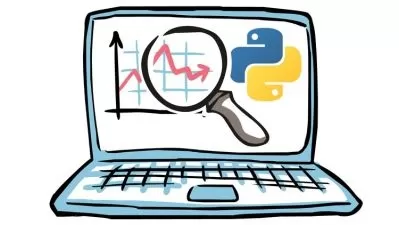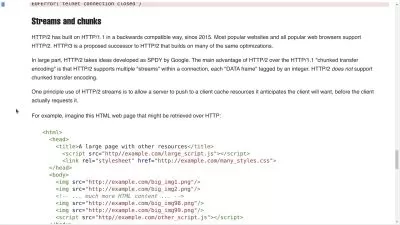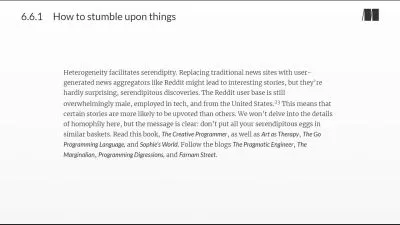Python - Data Analytics - Real World Hands-on Projects
Data Science Lovers
4:16:21
Description
A step to become a Data Analyst in this competitive job market
What You'll Learn?
- Big Data Analytics with Python
- How we complete the tasks related to data analytics with python
- Solving real time questions with Python Pandas Library
- Learn Python Libraries - Pandas, Matplotlib and enhance your analytical skills
- Core Python Programming Language
- Basic Data Science
- Download the Source Codes and Datasets of all projects
- You will enjoy it !
Who is this for?
More details
DescriptionIn this course, we have uploaded 8 Data Analytics projects, solved with Python.
These projects are useful if you are looking for a starting level job as a Data Analyst.
These projects are useful for career transition into data analytics field.
If you are a student, you can use these projects to submit in college/institute.
The source code and datasets files are available to download.
All the projects are created with a very easy explanation.
We have mainly used the popular Python Pandas Library to solve these projects.
Kindly go through the description of each video lecture for more details.
The projects are :
Project 1 - Weather Data Analysis
Project 2 - Cars Data Analysis
Project 3 - Police Data Analysis
Project 4 - Covid Data Analysis
Project 5 - London Housing Data Analysis
Project 6 - Census Data Analysis
Project 7 - Udemy Data Analysis
Project 8 - Netflix Data Analysis
Some examples of commands used in these projects are :
The commands that we used in this project :
* head() - It shows the first N rows in the data (by default, N=5).
* shape - It shows the total no. of rows and no. of columns of the dataframe
* index - This attribute provides the index of the dataframe
* columns - It shows the name of each column
* dtypes - It shows the data-type of each column
* unique() - In a column, it shows all the unique values. It can be applied on a single column only, not on the whole dataframe.
* nunique() - It shows the total no. of unique values in each column. It can be applied on a single column as well as on the whole dataframe.
* count - It shows the total no. of non-null values in each column. It can be applied on a single column as well as on the whole dataframe.
* value_counts - In a column, it shows all the unique values with their count. It can be applied on a single column only.
* info() - Provides basic information about the dataframe.* size - To show No. of total values(elements) in the dataset.
* duplicated( ) - To check row wise and detect the Duplicate rows.
* isnull( ) - To show where Null value is present.
* dropna( ) - It drops the rows that contains all missing values.
* isin( ) - To show all records including particular elements.
* str.contains( ) - To get all records that contains a given string.
* str.split( ) - It splits a column's string into different columns.
* to_datetime( ) - Converts the data-type of Date-Time Column into datetime[ns] datatype.
* dt.year.value_counts( ) - It counts the occurrence of all individual years in Time column.
* groupby( ) - Groupby is used to split the data into groups based on some criteria.
* sns.countplot(df['Col_name']) - To show the count of all unique values of any column in the form of bar graph.
* max( ), min( ) - It shows the maximum/minimum value of the series.
* mean( ) - It shows the mean value of the series.
Who this course is for:
- Anyone looking for Data Analyst job
- Students looking for Data Analytics Projects
- Beginner & Intermediate Python Programmers
- Anyone wants to enhance big data analysis skills
In this course, we have uploaded 8 Data Analytics projects, solved with Python.
These projects are useful if you are looking for a starting level job as a Data Analyst.
These projects are useful for career transition into data analytics field.
If you are a student, you can use these projects to submit in college/institute.
The source code and datasets files are available to download.
All the projects are created with a very easy explanation.
We have mainly used the popular Python Pandas Library to solve these projects.
Kindly go through the description of each video lecture for more details.
The projects are :
Project 1 - Weather Data Analysis
Project 2 - Cars Data Analysis
Project 3 - Police Data Analysis
Project 4 - Covid Data Analysis
Project 5 - London Housing Data Analysis
Project 6 - Census Data Analysis
Project 7 - Udemy Data Analysis
Project 8 - Netflix Data Analysis
Some examples of commands used in these projects are :
The commands that we used in this project :
* head() - It shows the first N rows in the data (by default, N=5).
* shape - It shows the total no. of rows and no. of columns of the dataframe
* index - This attribute provides the index of the dataframe
* columns - It shows the name of each column
* dtypes - It shows the data-type of each column
* unique() - In a column, it shows all the unique values. It can be applied on a single column only, not on the whole dataframe.
* nunique() - It shows the total no. of unique values in each column. It can be applied on a single column as well as on the whole dataframe.
* count - It shows the total no. of non-null values in each column. It can be applied on a single column as well as on the whole dataframe.
* value_counts - In a column, it shows all the unique values with their count. It can be applied on a single column only.
* info() - Provides basic information about the dataframe.* size - To show No. of total values(elements) in the dataset.
* duplicated( ) - To check row wise and detect the Duplicate rows.
* isnull( ) - To show where Null value is present.
* dropna( ) - It drops the rows that contains all missing values.
* isin( ) - To show all records including particular elements.
* str.contains( ) - To get all records that contains a given string.
* str.split( ) - It splits a column's string into different columns.
* to_datetime( ) - Converts the data-type of Date-Time Column into datetime[ns] datatype.
* dt.year.value_counts( ) - It counts the occurrence of all individual years in Time column.
* groupby( ) - Groupby is used to split the data into groups based on some criteria.
* sns.countplot(df['Col_name']) - To show the count of all unique values of any column in the form of bar graph.
* max( ), min( ) - It shows the maximum/minimum value of the series.
* mean( ) - It shows the mean value of the series.
Who this course is for:
- Anyone looking for Data Analyst job
- Students looking for Data Analytics Projects
- Beginner & Intermediate Python Programmers
- Anyone wants to enhance big data analysis skills
User Reviews
Rating
Data Science Lovers
Instructor's Courses
Udemy
View courses Udemy- language english
- Training sessions 8
- duration 4:16:21
- English subtitles has
- Release Date 2023/05/04



















